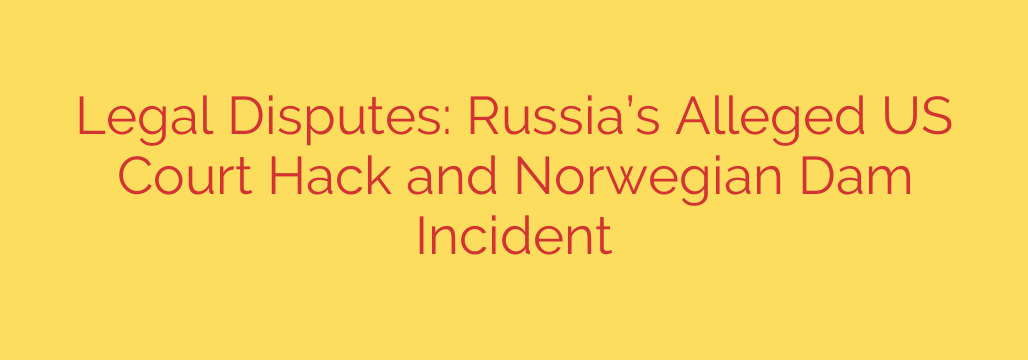
State-Sponsored Espionage: US Courts and European Infrastructure in the Crosshairs
The landscape of international conflict is rapidly evolving, moving beyond traditional battlefields into the digital and physical infrastructure that underpins modern society. Two recent, and seemingly separate, international incidents highlight a disturbing trend: the targeting of legal systems and critical energy infrastructure by state-sponsored actors. These events serve as a stark reminder that cyber espionage and physical surveillance are potent tools in the modern geopolitical playbook.
A Brazen Hack on the American Justice System
In a significant move, the U.S. Department of Justice (DOJ) has unsealed an indictment charging Russian intelligence officers with a sophisticated cyberattack on the federal court system. This wasn’t a random act of digital vandalism; it was a targeted campaign of espionage aimed at the heart of American law.
The operation, allegedly carried out by officers of Russia’s Federal Security Service (FSB), focused on stealing vast quantities of sensitive documents from the Public Access to Court Electronic Records (PACER) system. The stolen information was not public record; instead, the attackers sought confidential court filings, witness statements, and judicial communications that could provide a strategic advantage in legal disputes.
The method of attack is particularly noteworthy. The hackers didn’t assault the court’s digital fortress head-on. Instead, they first compromised the network of a law firm with legitimate access to the court’s filing system. By using the firm’s credentials, they were able to infiltrate the system and exfiltrate thousands of sensitive, non-public documents. This supply chain-style attack underscores a critical vulnerability for all organizations.
The primary implication of this breach is the erosion of judicial integrity. When one party in a legal dispute gains illicit access to their opponent’s strategy and confidential court records, the principles of a fair trial are fundamentally compromised. This act represents a direct assault on the rule of law itself.
Drone Surveillance Raises Alarms Over Critical Infrastructure
Across the Atlantic, another security incident has put European nations on high alert. Norwegian authorities recently arrested a Russian national for flying a drone over a critical dam, a key piece of the country’s energy infrastructure. This was not an isolated case of a tourist taking holiday photos.
Upon investigation, authorities discovered the individual was in possession of terabytes of data, including extensive photos and videos of sensitive sites across Norway. The incident comes at a time of heightened tension over European energy security, especially following the sabotage of the Nord Stream gas pipelines.
The concern is clear: this type of surveillance could be a precursor to espionage or even physical sabotage. Mapping out the security protocols, operational weaknesses, and key components of a power plant or dam from the air provides invaluable intelligence for any actor wishing to disrupt a nation’s energy supply. In response, Norway has taken the serious step of banning all Russian-operated drones from its airspace, highlighting the perceived level of threat.
Protecting Against Evolving Geopolitical Threats
These two events, though different in method, are linked by a common theme: the use of non-military tactics to gain intelligence and exert pressure. Whether through digital backdoors or physical surveillance, state actors are actively targeting the foundational systems of their adversaries. This new reality demands a proactive and comprehensive security posture from both governments and private organizations.
For businesses and institutions, several key security lessons emerge:
- Scrutinize Third-Party Risk: The U.S. court hack demonstrates that your security is only as strong as your weakest partner. Organizations must rigorously vet the cybersecurity practices of all vendors and partners who have access to their networks.
- Embrace a Zero-Trust Mindset: The old model of a secure perimeter is obsolete. A “zero-trust” architecture, which requires strict verification for every user and device trying to access resources on a network, can prevent attackers from moving laterally even if they breach an initial entry point.
- Enhance Physical and Situational Awareness: The drone incident is a powerful reminder that not all threats are digital. Critical infrastructure operators must have robust plans to detect and respond to unauthorized surveillance, including drone activity, near their facilities. Staff should be trained to recognize and report suspicious activity immediately.
Ultimately, the battlefield has expanded. Courthouses, power plants, and corporate networks are now on the front lines. In this environment, vigilance is not just a best practice—it is an essential component of national and organizational security.
Source: https://go.theregister.com/feed/www.theregister.com/2025/08/14/law_and_water_russia_blamed/








